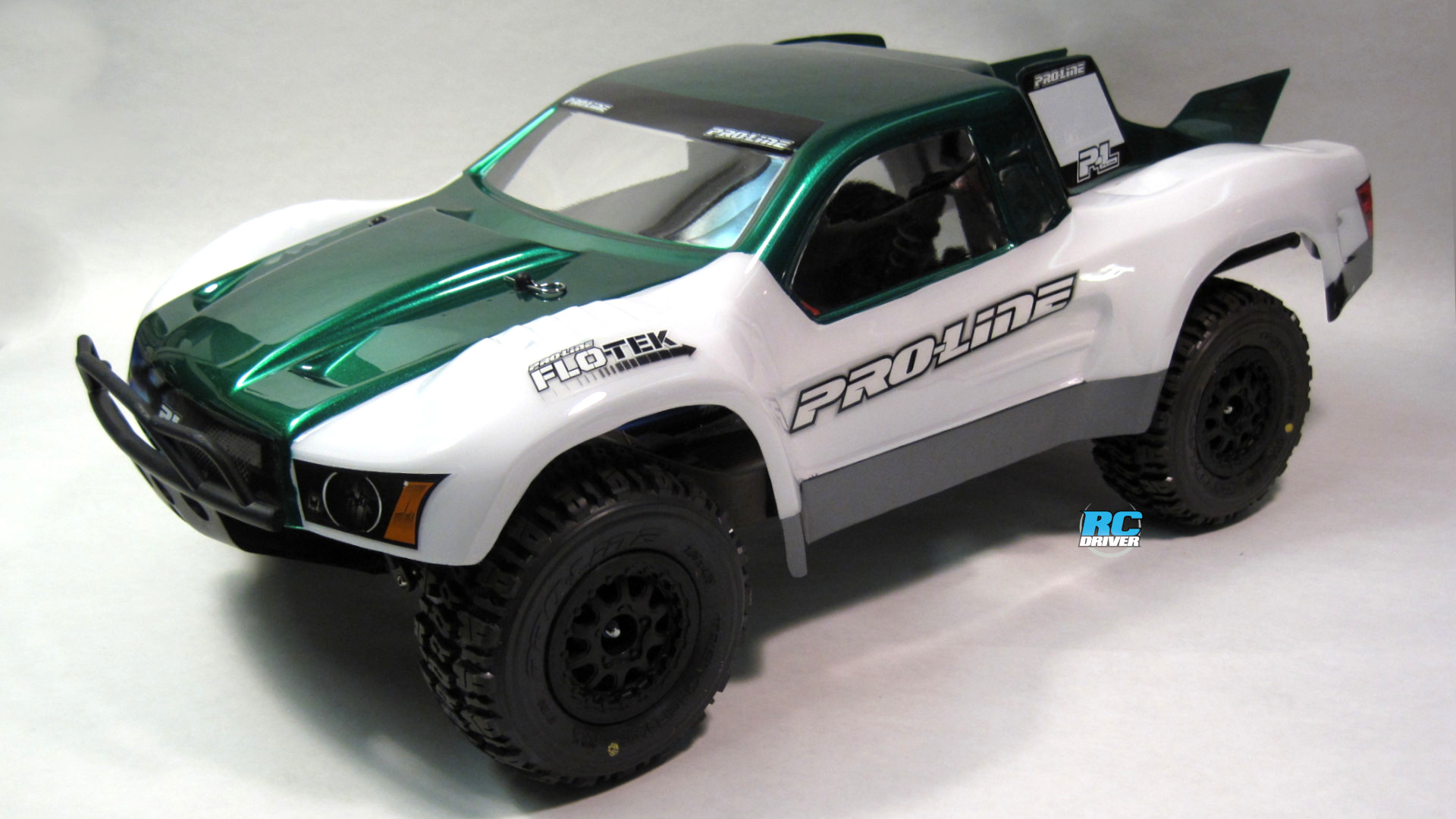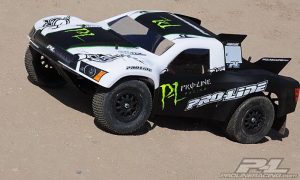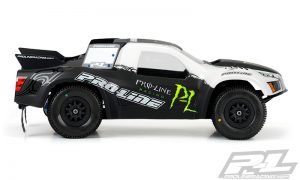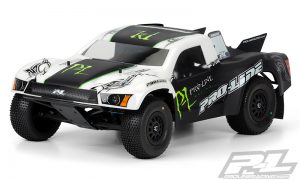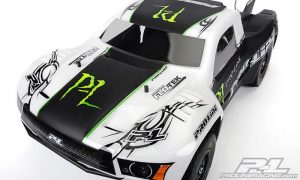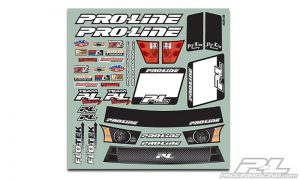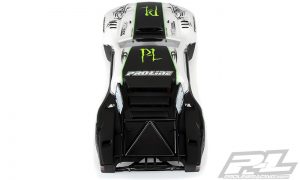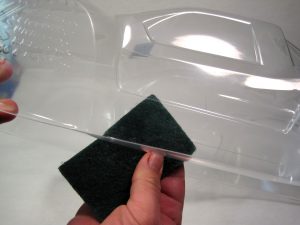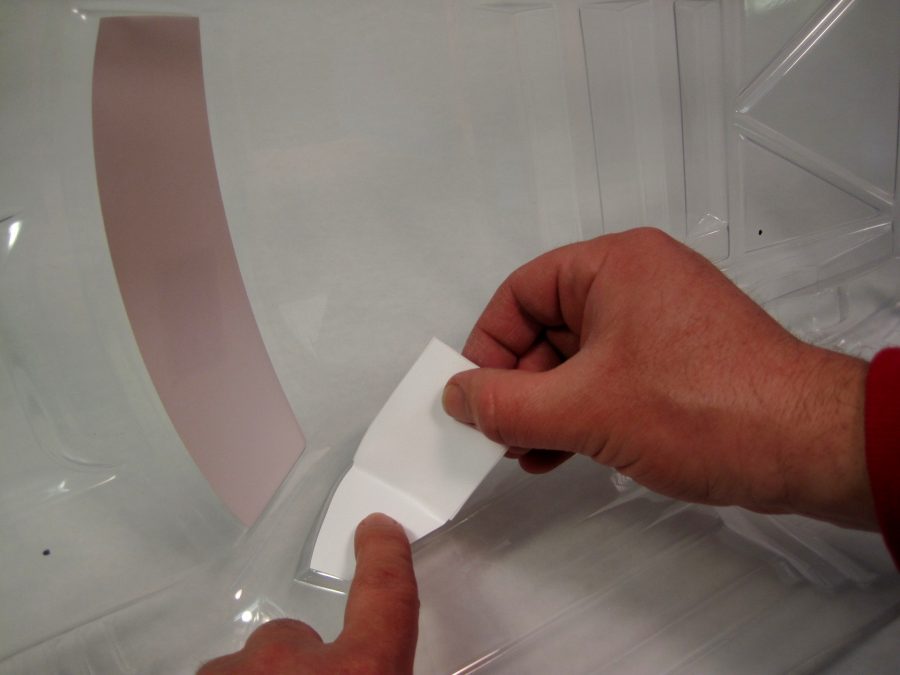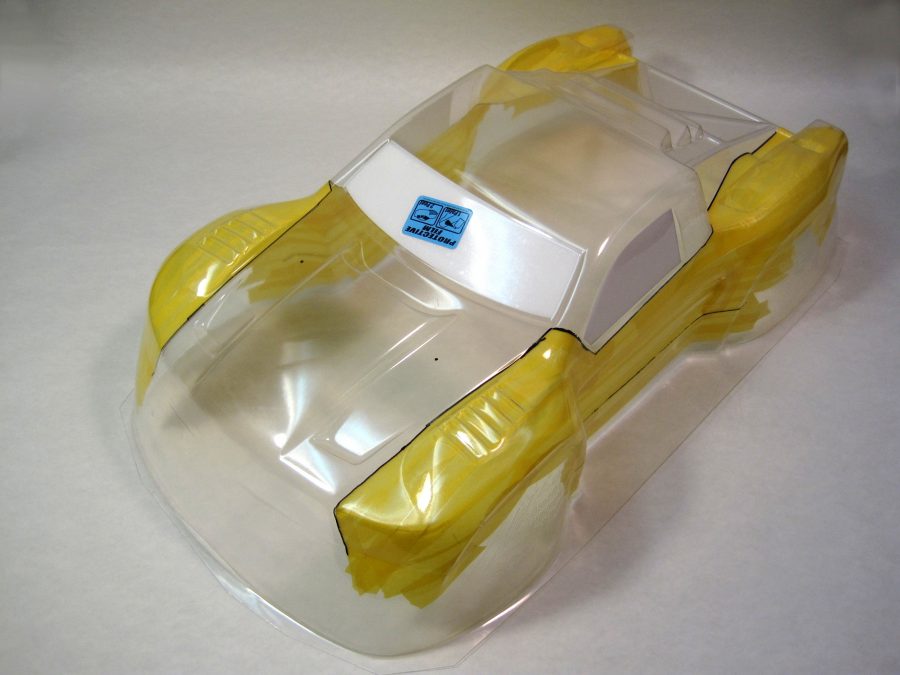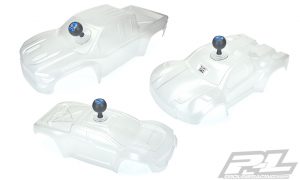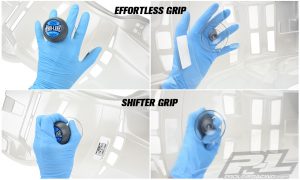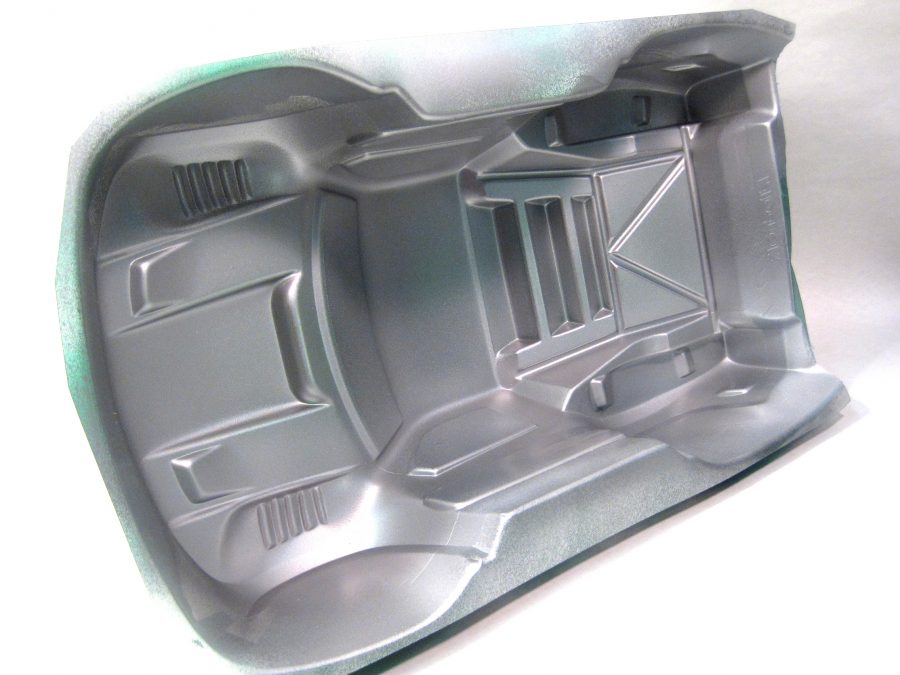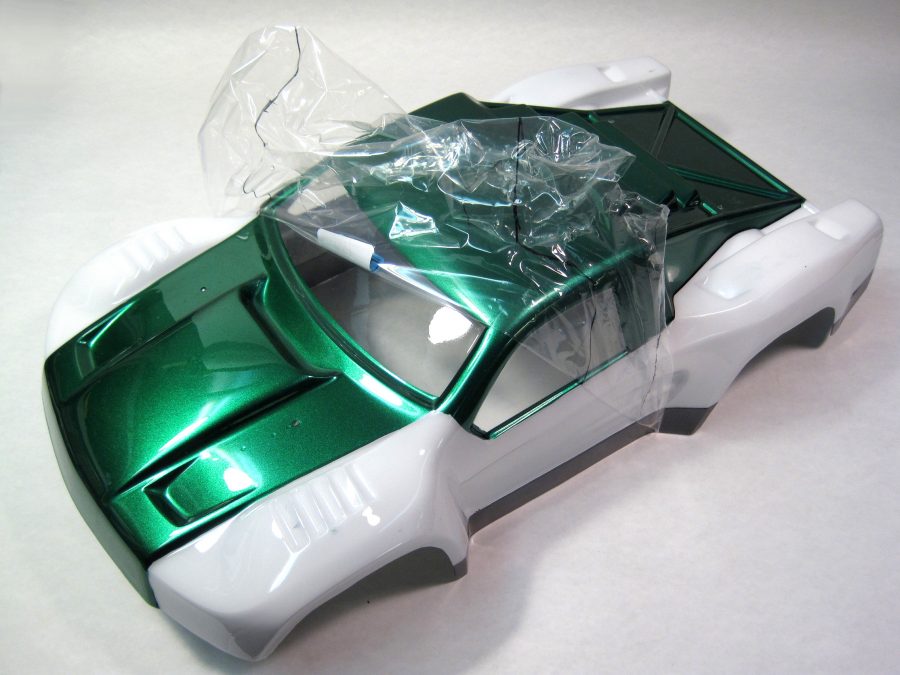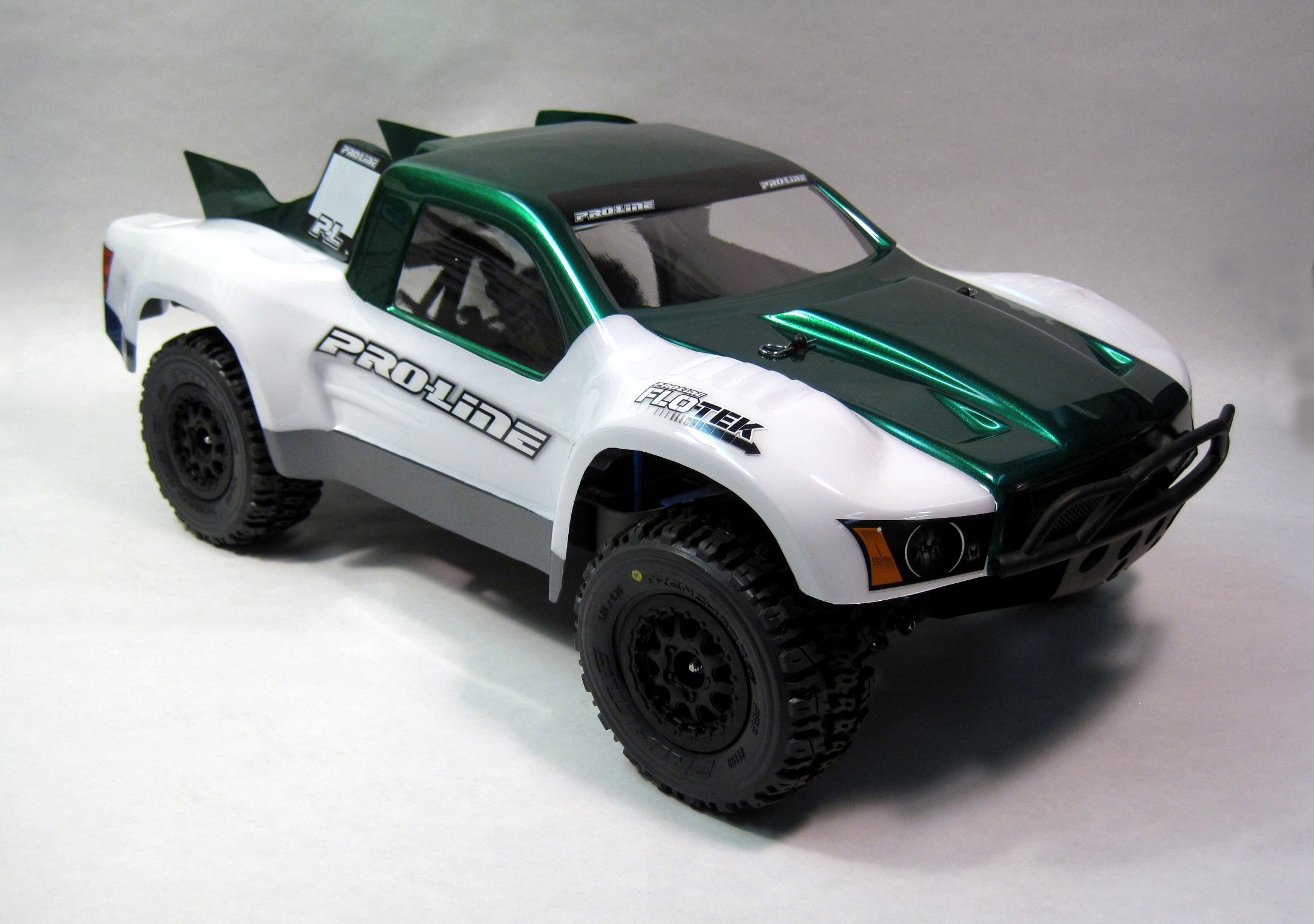SPONSORED ARTICLE
Being able to paint your own RC body is a useful skill to learn and it is not as difficult as you may think. Once you know the basics, you will be able to paint nearly any paint scheme that you can dream up. We are sure you own a ready-to-run (RTR) car or truck that has a body that is thrashed with scratches, tears and other body damage. Replacing that tired and worn body is a great way to breathe new life into your RTR and make it seem like you have a brand new ride. Here we will show you a simple rattle can paint scheme that anyone can do featuring a Pro-Line short course truck body.
STEP 1: PICK A BODY
Here is your chance to change up the look of your car or truck with a brand new body and a simple rattle can paint scheme. Just make sure that the dimensions of the new body will work with the chassis you have. Wheelbase is especially important so that the wheels will be oriented correctly within the wheel wells. There are numerous bodies to choose from for all types of vehicles and Pro-Line has a huge selection.
We have a used and abused Traxxas Slash 4×4 that we love to run at our local BMX track and it is in desperate need of a new body. We decided on the Pro-Line Flo-Tek clear body (#3355-00) because it was specifically 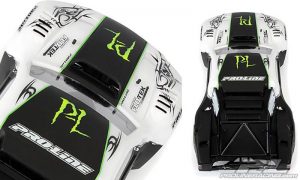 designed to minimize the parachute effect that is common with all short course trucks. Since the BMX track has loads of massive jumps and our Slash 4×4 sees a lot of airtime, the Flo-Tek body was the perfect match. Pro-Line gave the Flo-Tek short course body futuristic styling combined with large vent holes that allows the air from getting trapped under the body. The locations and size of the vents were cleverly placed so that the aggressive and high tech look would not be hindered.
designed to minimize the parachute effect that is common with all short course trucks. Since the BMX track has loads of massive jumps and our Slash 4×4 sees a lot of airtime, the Flo-Tek body was the perfect match. Pro-Line gave the Flo-Tek short course body futuristic styling combined with large vent holes that allows the air from getting trapped under the body. The locations and size of the vents were cleverly placed so that the aggressive and high tech look would not be hindered.
 BODY SPECS
BODY SPECS
Length: 21.5” (546mm)
Width: 9.3” (235mm)
Height: 6.0” (152mm)
Wheelbase: 12.7” (323mm)
STEP 2: DECIDE ON A PAINT SCHEME
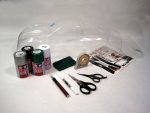
When coming up with a paint scheme, try to make it simple to start off with. Then as your skills improve you can tackle more elaborate paint jobs. For the Pro-Line Flo-Tek body, we are creating an uncomplicated three color paint scheme using Tamiya polycarbonate spray paint. We will end up using a total of four different colors. Three that will be visible when the body is completed and one used as a backing color. The spray paint colors that we are using are Tamiya PS-1 (White), Tamiya PS-17 (Metallic Green), Tamiya PS-23 (Gunmetal), and Tamiya PS-41 (Bright Silver). Obviously, if you want something even easier, use just two colors.
STEP 3: BODY PREP
Body prep is such an important step and if you skip it, the paint job will show it. Start off by scuffing the inside of the body with a Scotch-Brite pad which gives the paint something more to ‘grab’. Make sure you don’t scuff the windows if you want them to end up being clear. If you scuff them, they will have a hazy, scratched look to them.
Once the body is scuffed, wash the body with warm water and dish soap. This will remove any grime that found its way onto the body like the oils from your fingers and any residual mold release agent from when the body was made. Dry the body thoroughly with either a lint free cloth or a hairdryer. Now be careful to not touch the inside of the body because the oils from your fingers will stop the paint from properly adhering to where your fingers touched the body.
STEP 4: MARK BODY POST LOCATIONS AND WHEEL WELLS
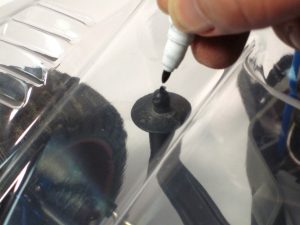 Make your life much easier by marking the locations for the body posts and wheel wells now. There are some bodies like the Pro-Line Flo-Tek that have dimples molded into the polycarbonate that let you know where to drill the body post holes. Pro-Line has dimples on the Flo-Tek body for the most popular short course trucks out there like the Traxxas Slash 4×4. We are marking the body anyway to illustrate this step.
Make your life much easier by marking the locations for the body posts and wheel wells now. There are some bodies like the Pro-Line Flo-Tek that have dimples molded into the polycarbonate that let you know where to drill the body post holes. Pro-Line has dimples on the Flo-Tek body for the most popular short course trucks out there like the Traxxas Slash 4×4. We are marking the body anyway to illustrate this step.
STEP 5: MASK WINDOWS
Most body manufactures include window masks so that the body ends up with clear windows once it is painted. I like that window masks that Pro-Line includes because they come precut to perfectly fit the shape of each window. It makes this step quick and easy. Be sure to burnish the edges of the masks to make sure paint can’t seep underneath and ruin the goal of a clear window.
STEP 6: PLAN-OUT THE PAINT SCHEME
Since the Pro-Line Flo-Tek body comes with overspray film on the outside 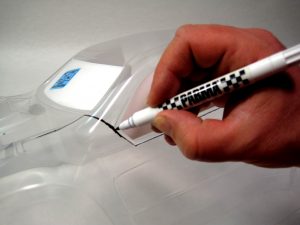 of the body, you can draw directly on it. We are using Parma’s dual tip detailing pen to layout the paint scheme that we want to achieve. Then we can use these marks as a guide when trimming out the paint mask. If you make a mistake, all you need is a little rubbing alcohol on a rag and it will remove the pen marks so you can try again. All of the marks from the detailing pen will disappear when you pull off the overspray film and they won’t be on the body. For this short course body, we are painting Metallic Green on the top section followed by Gunmetal along the bottom and White in-between.
of the body, you can draw directly on it. We are using Parma’s dual tip detailing pen to layout the paint scheme that we want to achieve. Then we can use these marks as a guide when trimming out the paint mask. If you make a mistake, all you need is a little rubbing alcohol on a rag and it will remove the pen marks so you can try again. All of the marks from the detailing pen will disappear when you pull off the overspray film and they won’t be on the body. For this short course body, we are painting Metallic Green on the top section followed by Gunmetal along the bottom and White in-between.
STEP 7: MASK LIGHTER COLORS FIRST
What you need to keep in mind when painting a polycarbonate body, is that you are painting the inside of the body. This means that the order of how you spray on the colors is reverse than what you would do if you painted the outside of the body. Always start off with the darkest color first and end with the lightest. If you don’t follow this method, the dark color will bleed through the lighter ones and wreck the paint job. For this Pro-Line Pro-Teck short course body, Metallic Green will be the first to get sprayed followed by Gunmetal and then White. Here you can see the Metallic Green section was left uncovered by the mask.
Using good quality paint mask will help ensure you end up with crisp separation lines between the colors. We like to use Tamiya masking tape. It comes in a variety of widths and is very easy to work with. A hobby knife is used to cut the mask to the desired shape. Be careful not to push too hard with the knife and score the body. Wherever the body is scored is a place where it can easily crack if the body bends or gets hit in a collision.
STEP 8: FIRST COATS ARE LIGHT COATS
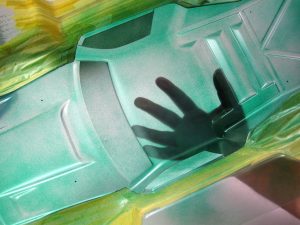 With each and every color, spray the very first coat nice and light. Light enough so that you can see through the paint and see your hand on the other side of the body like it is shown here. This light coat of paint will help ‘seal’ the edges of the masks and keep it from bleeding underneath. If you start with a heavier coat, the paint is more likely to find its way behind the mask. The next coat can be a bit heavier, but still stay on the lighter side.
With each and every color, spray the very first coat nice and light. Light enough so that you can see through the paint and see your hand on the other side of the body like it is shown here. This light coat of paint will help ‘seal’ the edges of the masks and keep it from bleeding underneath. If you start with a heavier coat, the paint is more likely to find its way behind the mask. The next coat can be a bit heavier, but still stay on the lighter side.
PRO-LINE BODY GRIP TOOL
The Pro-Line Body Grip Tool (#6349-00) is a super useful device made specifically for painting bodies. The suction cup bottom of the Body Grip Tool securely attaches to the body and allows you to hold onto the tool instead of the body and will keep you from getting your fingerprints in the wet paint and ruining the paint job.
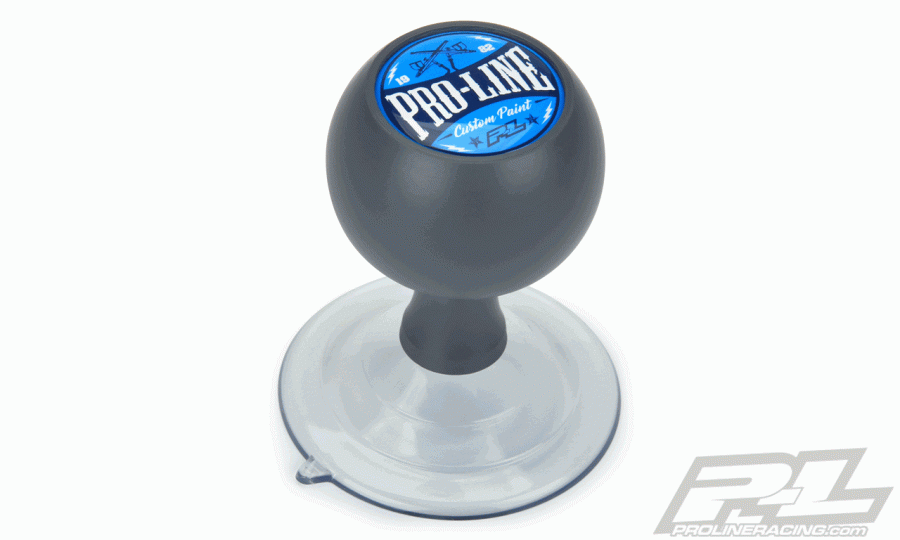
STEP 9: LET EACH COAT DRY
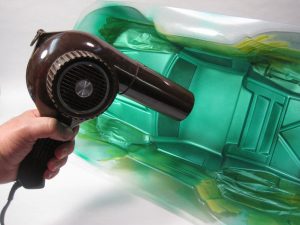 Don’t rush the paint job. It is important to let each coat of paint dry before applying the next coat. If not, you will end up with run marks from the heavy paint or wreck the appearance of a previous color. A hairdryer can speed up this process, just be careful not to get too close to the body which can be deformed from too much heat.
Don’t rush the paint job. It is important to let each coat of paint dry before applying the next coat. If not, you will end up with run marks from the heavy paint or wreck the appearance of a previous color. A hairdryer can speed up this process, just be careful not to get too close to the body which can be deformed from too much heat.
STEP 10: REMOVE MASK FOR SECOND COLOR
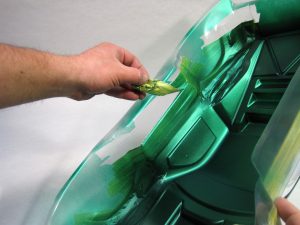 Once the Metallic Green section of the body was dark enough and dry, we removed the mask that covered the Gunmetal section. Carefully remove the mask while not disturbing the mask that needs to stay in place to cover the white sections of the paint scheme. With the mask removed, we then sprayed the Gunmetal following the steps mentioned above.
Once the Metallic Green section of the body was dark enough and dry, we removed the mask that covered the Gunmetal section. Carefully remove the mask while not disturbing the mask that needs to stay in place to cover the white sections of the paint scheme. With the mask removed, we then sprayed the Gunmetal following the steps mentioned above.
STEP 11: TAKE OFF REMAINING MASK FOR THIRD COLOR
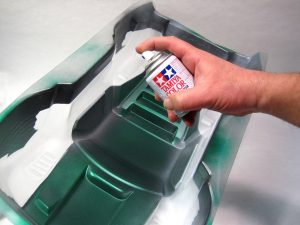 Time to lay down the white with the Metallic Green and Gunmetal colors completed. All of the mask is now removed except for what is on covering the windows. After enough coats of white are sprayed to properly cover the area, we were then in the home stretch.
Time to lay down the white with the Metallic Green and Gunmetal colors completed. All of the mask is now removed except for what is on covering the windows. After enough coats of white are sprayed to properly cover the area, we were then in the home stretch.
STEP 12: BACK THE PAINT JOB WITH SILVER
This is an added step that we like to do to make the paint scheme have a deeper look and be entirely opaque. It looks hack if you are able to see through the body, even partially. We use Silver to back the whole paint scheme. Silver does an awesome job with metallic colors where it really makes them pop. When the paint is dry, remove the window mask.
STEP 13: TRIM AND DETAIL BODY
This is our absolute favorite part of painting an RC body…removing the overspray film. But before you rip off the film, ream out the body post holes using the marks you made earlier. Now trim off the excess polycarbonate and cut out the wheel wells using curved body scissors. At this point in the painting process, the body looks quite dull and messy because the off the overspray film itself along with overspray from the paint and any of the marks you made with the pen. As you pull off the film, the body transforms into a super glossy and shiny finish. The last thing to do is to put stickers on the body and your custom painted body will be finished.
Remember with the Pro-Line Flo-Tek body that there are the serious of holes that you can open up in the body to allow airflow through the body. Check out the following video that gives you different options on getting the openings cut out.
STEP 14: MOUNT YOUR CREATION ON THE CHASSIS
Here is our newly painted Pro-Line Pro-Tek SC body mounted on our Traxxas Slash 4×4 chassis. The finished product for this simple rattle can paint scheme looks great and is a welcome upgrade from the stock RTR body which had seen its fair share of scratches, scuffs and dents from hard off-road running. We will most likely add more stickers to help dress-up the body even more. Hopefully this article will get you to try your hand at creating your own custom painted body.
SHOP PRO-LINE RACING
Use code RCDRIVER10 to save 10% your order at https://www.prolineracing.com/
SPONSORED ARTICLE
*Notice: Some of our articles, videos and descriptions may contain affiliate links, which means that if you click on one of the product links, we may receive a small commission. This helps support the website and social media channels and allows us to continue to produce content. Thank you for the support!
 RC Driver The Best In RC Car & Truck News, Reviews & Video
RC Driver The Best In RC Car & Truck News, Reviews & Video 



